
Welcome to Imperial County, California, the poorest, hottest, heaviest water-consuming county in the state. I've been here for a week and will be in town for one more, studying the New River, which has earned the dubious distinction of being the dirtiest river in the United States (some also say it's the dirtiest in North America, but the jury has yet to reach a verdict). Those are phosphates flowing across the international boundary with Mexico, which is just to the left of my photo. In Mexico, it's still acceptable to use phosphates in detergent and other products, which wouldn't actually be a huge deal...except that the toxicity of the river means the foam has come into contact with all sorts of nasty viruses, fecal coliform, VOCs (volatile organic compounds) and chemicals...which still wouldn't be too much of a problem, except that it's windy here in the IC, and the foam tends to blow across the street into the parking lot of the adjacent grocery store. When the foam blobs are house-sized and blat onto produce stands by the front door, people tend to get upset.
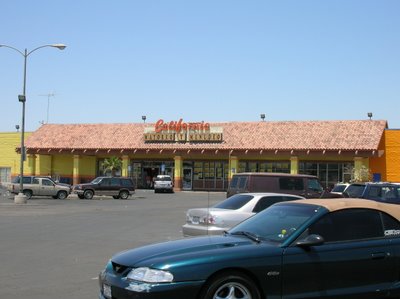
This is the grocery store with the foam blat problem. I'm incredibly disappointed that I haven't seen any house-sized blobs yet, but I don't really want to stick around until one rolls across the pavement, since the summertime highs here get into the 120-range. What have I seen in the river? Well...
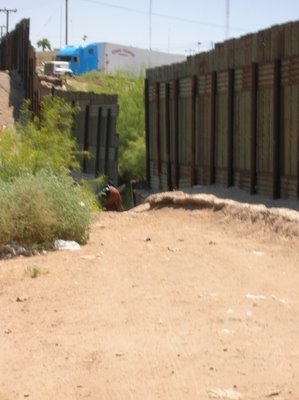
It's a terrible shot, but I was in a sprint to snap the photo before he disappeared back across the border. There was a film crew in town from PBS in LA, and I joined them to listen in as they shot a documentary on the pollution situation here. Apparently, as we worked near the border, we flushed a migrant who'd been hiding in the bushes next to the river. He trudged out slowly, clad only in a pair of maroon shorts, holding a black plastic garbage bag filled with belongings. None of us even noticed him until one of the local water experts, Jose, said, "Hey, look what we found!" Most of Calexico, the town where I'm staying, is Latino; the majority are recent immigrants from Mexicali, Guadalajara, or further south -- but they have ambivalent feelings about the influx of illegal immigrants who cross the New River every night. Anyway, Jose told me to go take a picture, so I started towards him, which is when he started running. Before we knew it, he'd splashed straight into the river and waded back into Mexico. See, the river is so toxic that the Border Patrol won't go in after you, so it's a popular aquatic highway for migrants to use. I've been bugging the patrol all week to let me ride along and watch people cross, but I think I'm just going to drive down to the bridge myself and sit there for a couple of hours tomorrow night.

The banks of the river are lined with discarded clothing, underwear, plastic bags and garbage. The Border Patrol estimates that 40 - 60 people cross here each night, with a peak of 100 - 150 during the cooler season. Right now, it's getting brutal outside during the day (although people here think it's pretty cool, all things considered). It won't be long before the weather takes its toll on people crossing; each year, several dozen immigrants die in the deserts. I've driven within walking distance of places where it's happened.
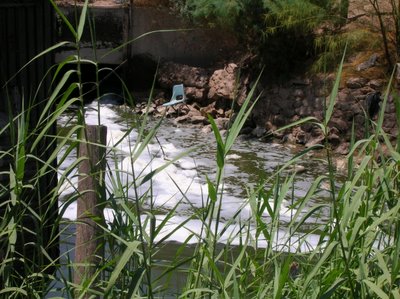
This is the international boundary. The area where the foam originates is actually not the New River -- it's an outlet for a lot of the wastewater from Mexicali. Right now, they're completing a wastewater treatment plant with help from BECC and NADBank, two environmental development agencies created by side agreements in NAFTA. Once that goes online at the end of the year, pollution should decline to a level where it will be easier to confront on the US side. Everyone here talks about Mexican sewage, but it's easy to forget that an equal number of problems originate in the US. The IC is the heart of agriculture country -- and where there's ag land, there are pesticides by the ton. I've driven past fields of melons, onions, sawgrass, sugar beets, oranges, lettuce...you name it, it's grown here. You buy it? It probably came from here, too. On every field, I've seen men clad in heavy gloves and protective clothing, spraying a brightly colored assortment of liquids onto the food. Between that and the endless feedlots with thousands upon thousands of cattle, it's enough to make me swear off eating for life.
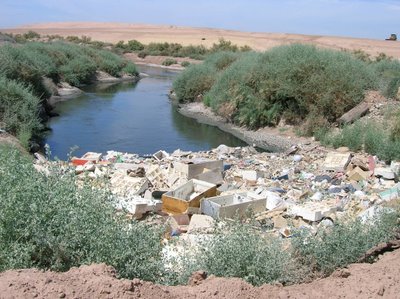
The chemicals and sewage are problematic, but dumping is another problem. The PBS crew filmed in Mexicali on Wednesday and saw huge trucks pumping gallons of murky brown substances into the water...but this shot is from Calexico, and there's a river under all that crap that flows north to the Salton Sea. Everyone treats this river like an open sewer, a place to get rid of all the refuse you don't want anymore. They've put up fences to block dumpers from throwing their refrigerators into the river, but so far it seems like people just peel back the chain link and drive right up to the shore. Or, they go around the fence. IC has unique attitudes about the environment that are too complex to parse out here without a lot of writing. Long story short, the Imperial Valley has long had access to the cheapest water in the world, thanks to its reliance on Colorado River water. I think the IV uses something like 75% of the water allocated to California, and it's all for 500,000 acres of farmland. With increasing demand for water in urban areas like San Diego and Los Angeles, pressure's on for the state to pay farmers not to farm, diverting water to the cities. See, Cali's exceeded its share of the Colorado by an incredible amount, and now the other basin states are forcing it to stick to its original allocation. This means that people here are feeling incredibly defensive about their water. The county may be poor, but some people are very, very rich, and they're used to the environment doing whatever they want it to do. The population is growing, the water is diminishing...the area is a powder keg in many ways, and dumping is only one indication of the work that needs to be done to teach residents that there's just nothing left to abuse anymore.

Alas, what you can't experience through these photos is the smell of the New River. It's a legendary odor, cited for decades by Calexico developers who blame it for their stagnant growth. I have a terrible sense of smell, but even I grew a little ill when I spent an afternoon touring sites around Calexico (in sandals, because I am stupid -- I'm sure my feet classify as a Superfund site now). I couldn't get the smell out of my clothes, my skin, my nose for two days. It's a combination of tar, garbage, sewage, decay and chemicals that scorches the back of your nasal passages. It takes your breath away, but you can't hold it long enough to avoid getting a whiff. In the stifling late spring heat, when the wind blows the right way, it's enough to make you feel light-headed within minutes. There are people who live within 200 feet of the river. When they go on vacation, they literally seal off their houses: tape the windows, block the doors. It doesn't work. Upon their return, the houses reek of the river, and there's nothing they can do about the odor once it gets inside. Maybe that's why there are so many household items in the makeshift dumps...
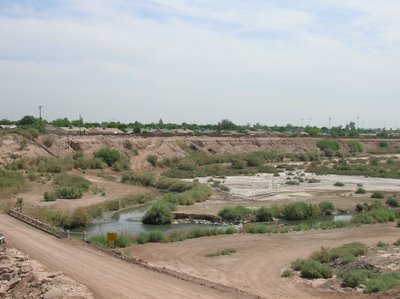
The up-side to all of this? I'm learning a ton, perversely enjoying the experience....and I get to offroad all the time. I had no idea that driving a 4x4 around a bunch of sandy, rutted "roads" and spinning out in the dirt could be so damned fun. After a few days, I'm now on a mission to see how filthy the exterior of a rental Jeep can become. So far, I'm doing pretty well. People here have gone from giving my car a double-take because it's new (trust me, I wanted an old one) to looking twice because I'm pretty sure it resembles a ball of dirt on wheels. I'll get a photo before I'm forced to wash the windshield, which has so many bug splatters on it that I'm having trouble seeing at dusk.
I've also been forced to use my Spanish like never before, and it's been great. I went to Calexico's sister city of Mexicali (Baja California, Mexico) last night and managed to carry on a very long conversation with Jose and his friend without completely embarrassing myself. Speaking Spanish is important here: as a white person, I already stand out in a fairly negative way. If I can speak both languages, I've been told, it lets people know that I'm "not a racist." It's always awkward deciding which language I should use when I have to initiate a conversation -- I don't want to offend anyone by assuming they don't speak English, but at the same time I don't want them to feel like they have to speak English because there's another dumb gringa who just wandered into the local store. So far, I've managed to get by without too many problems...except for that first afternoon, when I ordered bread and wound up eating something that was either pumpkin or dead animal. I'm still not sure.
There's so, so much to write. I saw colonias in Mexicali, the makeshift shantytowns on the edges of the maquiladoras, and I want to describe them because I think it helps people understand why water quality really isn't a top priority there right now. I want to write about how this region feels like a country unto itself, somehow both American and Mexican, completely amazing and entirely integrated. I want to write about the Salton Sea and its slow, painful demise; about the efforts people are making to save what they can; about Niland, California, which you sort of have to see to believe (let's just say Deliverance, but tanner). So I promise to write more this weekend, in between study breaks. Tomorrow night, I'm off to the 15th annual Mariachi sin Fronteras (Mariachi without borders) festival in Calexico. I have no idea what to expect, but apparently it's a gigantic event that draws people from all over the region. Full report coming soon.

1 comment:
Fascinating report. Congratulations for using your Spanish too. I end up using what little Spanish I know at work now and then and feel a little smarter because of it.
Use your sunscreen!
Post a Comment